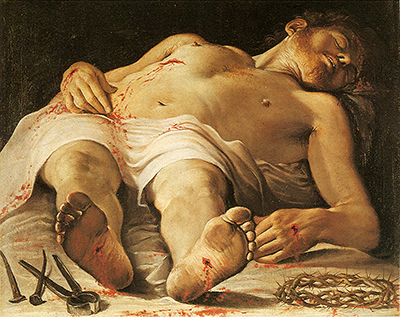This piece of work dates to Annibale Carraci's early career and it is homage to Andrea Mantegna’s Dead Christ. The dead Christ is seen lying in twisted position, seen from his feet. Unlike Mantegna’s painting, Carracci didn’t paint the mourners at the side of the body but he instead adopted a realistic depiction of the body.
The Corpse of Christ painting is one of Annibale Carracci dating to c 1583 to 1585 and it is currently housed in the Staatsgalerie of Stuttgart, Germany. Annibale started working on this painting in c. 1583 and he completed it in 1585. The painting lies in the religious paintings genre and the material used is oil on canvas. The dimensions of the corpse of Christ's painting are 70.7 cm by 88.8 cm.
This is one of the most touching images in the National Gallery-the lamentation over the death of Christ after his death. It is also one of the most-detailed expressions of grief in Barroque art. Christ is seen lying with his limb and lifeless body on the ground in a sorrowful state. Various Gospels differ in the accounts of what happened to Christ after death. This is the reason there is confusion about the women who mourned him. The conventional stories following the crucifixion focus on the dead body of Christ and the moment his body was discovered in the tomb. In Annibale’s painting, he has compressed all the episodes in a way that it brings out a great emotional impact. This is the last in several variations on the theme of the pieta, to which the artist returned frequently, most especially during the last years of his life.
The composition of the Christ’s body painting is built on strong diagonals and great colour, gaze and expression. Christ’s lifeless body and limp are laid out in the foreground which shows a lot structurally and emotionally. Christ’s torso is elongated and the tones changes from a cool blue to warmer flesh colours. With all this use of colour and balancing, all the attention is drawn back to Christ. Annibale has used his skills to concentrate the attention in the figure and bring out an emotional response in return. He has the ability to paint different emotions and it is one of the things that make this painting admirable. This painting is an amazing combination of formal classicism and human sentiment. This painting puts Annibale’s art on the same level as that of the great Renaissance painters Raphael and Correggio.
Related Works
These are some other works of different artists that are similar to Annibale’s painting of the corpse of Christ:
- Rest on the Flight into Egypt by Caravaggio
- Supper at Emmaus by Caravaggio
- Crowning with Thorns by Caravaggio
- Taking of Christ by Caravaggio
- The Holy Family with Saints Anthony Abbot, Catherine and the Infant St. John by Agostino Carracci




